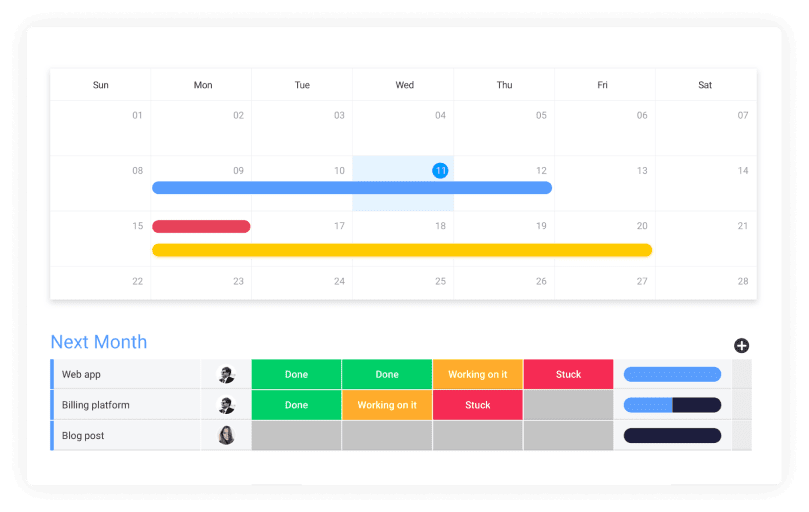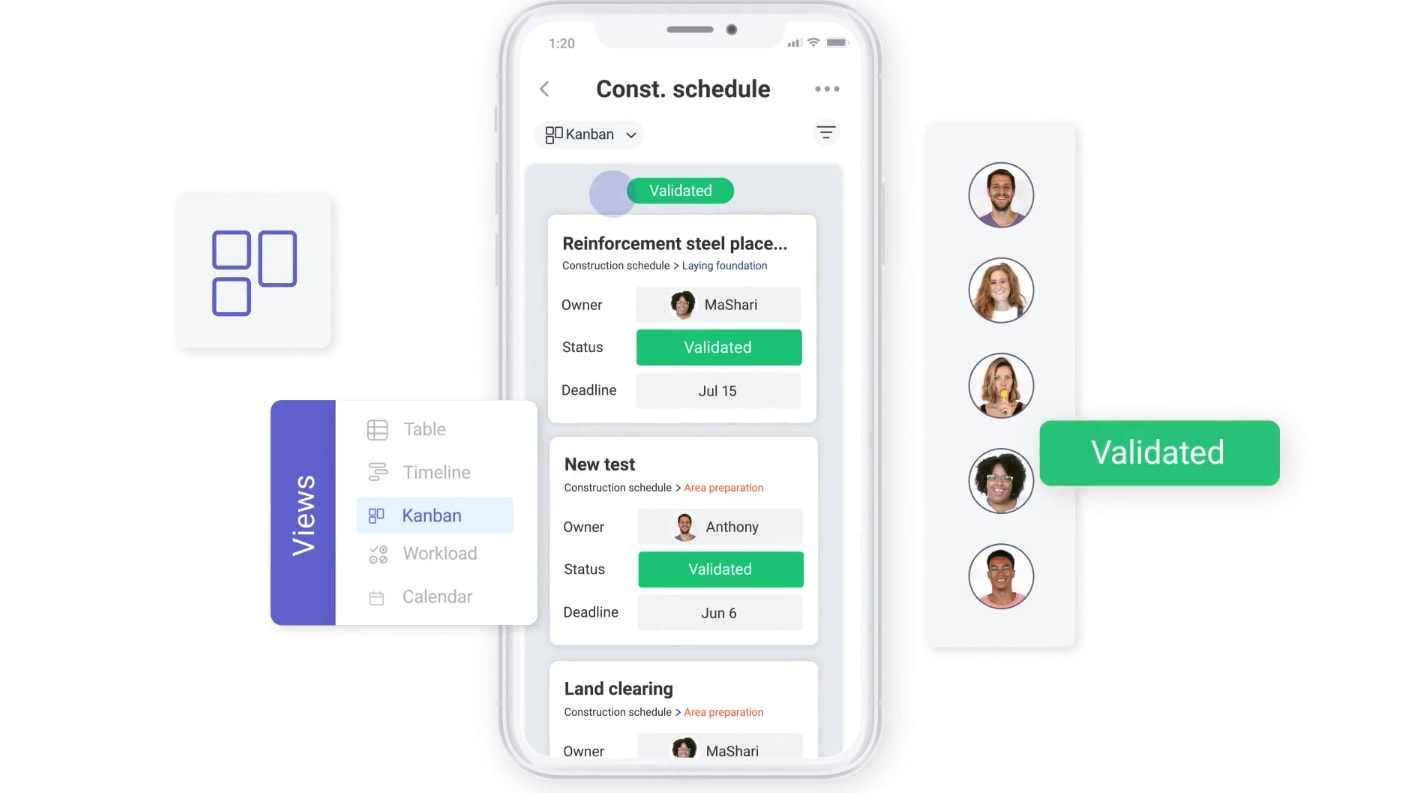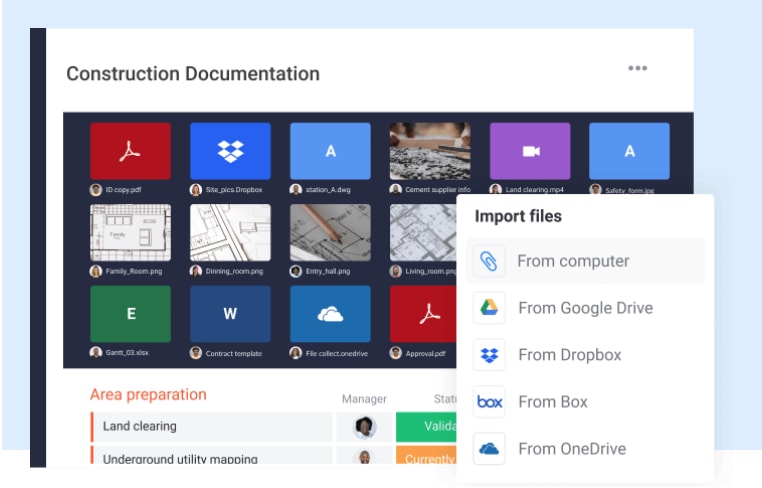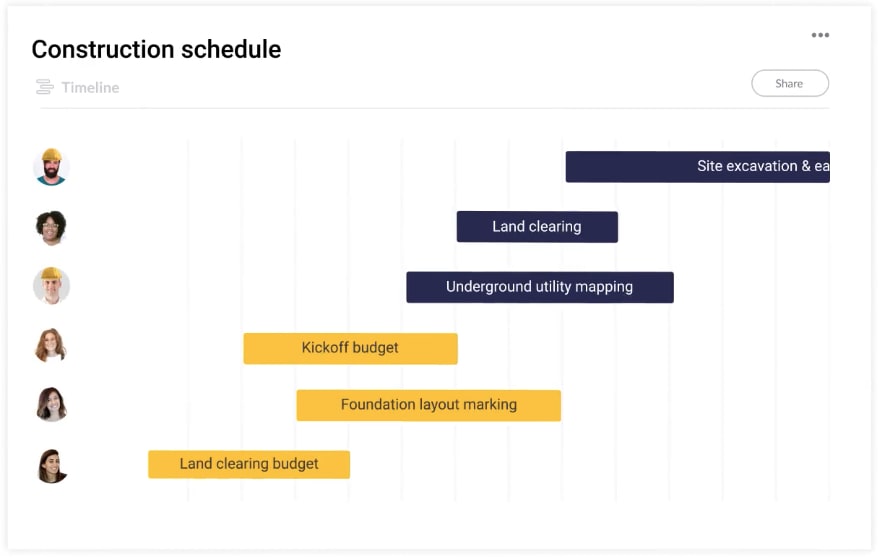If you’re in the building and construction industry, we don’t have to tell you how complicated managing large-scale construction projects can be.
Between juggling multiple teams, demanding deadlines, and sequential workflows, things can often start to deteriorate before you even hit the go button.
Fortunately, we know a thing or two about the subject and have even developed a platform that allows you to set construction projects to ‘easy mode.’ But more on that later.
For now, here’s everything you need to know about construction project management, starting with a quick overview and followed by common phases every construction project entails.
Let’s get rolling.
An overview of construction project management
The main elements of construction project management (CPM) include planning, coordination of logistics, budgeting, and overseeing the primary activities of a construction project.
A construction project manager liaises with suppliers, contractors, and the building team. Together, they formulate a budget, design project timelines, build activity-specific schedules, and update the planning documents as any changes occur. All in a day’s work. But to do all of this, they need the right tools on hand.
Specialist construction project management software is changing the landscape of the industry. Such options allow project managers to:
- Create and share schedules with subcontractors (and clients)
- Send automated project updates
- Analyze progress data and reports
- Manage project budgets
These specialty programs are great, but they can be pricey and cumbersome to use. the good news is that there are general-use digital workspaces available on the market that offer the functions above and integrate with your other business operations for significantly less than the industry-specific options.
One example may or may not rhyme with fun-day.com.
Does CPM software really add value?
You may be thinking, ‘Why should I spend the time familiarizing myself with new software if we’ve been building for millennia without it?’
Well, consider how much faster it is to use a chainsaw than it is a handsaw or a jackhammer than a sledgehammer…
Technology is what’s made our lives easier and more efficient in so many areas – and the construction industry is no exception.
Conducting CPM activities on one digital platform empowers a construction manager to harness:
- Effective task management: You can quickly add and change tasks and assignees as needs and plans change.
- Budget management: Keep track of project spend live to make sure you’re always within budget.
- Improved productivity: With every task delegated and synchronized, all involved construction professionals can see who’s doing what and when.
- Better collaboration: Being cloud-based makes it easier to share and communicate in real-time.
- One centralized location: Allow subcontractors, clients, and other stakeholders to access the information they need when they need it.
- Integrations: Use and share resources from other tools and platforms in one place.
For example, with monday.com’s construction project management templates you can quickly and easily see the status of each part of your build, and automatically receive notifications as tasks are completed:

Having acknowledged that technology can bring you joy and efficiency, let’s move swiftly on to the phases of the construction process, and explore the ways in which a digital project workspace might be able to help.
What are the phases of construction project management?
The basic phases of construction project management are common to essentially every project, regardless of size.
Before the real work begins, a project needs to go through the preliminary stages of approval, determining the goals, costs, and timeline of the proposed project to establish its feasibility.
If you’re given to go ahead, it’s time to start phase one.
1. Planning and development
Sometimes called the ‘conception’ phase, this is where you imagine and commit to the general outline of the project.
A construction project manager’s client will offer up interesting (and potentially borderline impossible) suggestions for the project. These proposals will then be relayed to an architect and possibly a general contractor to get a sense of what can be realized in practice.
Once everyone agrees to the design, the construction manager will find suitable land and/or existing property locations for the project and run risk-assessments to determine which location is the most appropriate.
Finally, the project manager will instruct a subcontractor to draft up initial concept pre-designs as CGIs (computer graphic images) to get a sense of the ideal final product.
monday.com for teams
Even blue sky thinking needs a bit of direction, so we designed monday.com’s construction project management software to put you in the driver’s seat when arranging your planning and development team.

Whether you’re working from your desktop computer or your mobile phone, you can assign an architect the task of providing an outline for the CGI subcontractor, and set it up so they are automatically notified when it’s finished! Beats playing email ping-pong.
2. Design
In the design phase, the concept for the building or development is committed to one document known as the ‘schematic’.
The schematic draws upon critical data gathered from the planning and development phase to produce a detailed sketch of the building that specifies size, elevation, floor plan, and materials.
The project manager should conduct further research at this stage to refine the client’s initial ideas and smooth over any potential obstacles. You may want to update the CGIs to reflect the final ideas.
All the documents produced so far including the CGI, schematic, and construction drawings are, once finalized, collated and sent to contractors to bid on the job. Now the real fun begins.
monday.com integrations
To make your life easier, monday.com has integrations for over 200 third-party applications. This means your contractors can happily avoid switching from their existing construction software to yours in order to be on the same page.

Usually, a complicated process, drawing up the schematic is a cinch when you can gather all the necessary documentation in one place from whatever tools your contractors prefer.
3. Pre-construction
At this point, the project manager will have selected a contractor or construction company for the project after a bidding round.
Before they ‘break ground’ as they say in the industry, it will be necessary to appoint a project management team.
This includes a contract administrator, a project manager, a superintendent, and a field engineer.
These key team members will all have to coordinate their personal responsibilities around everyone’s respective schedules to ensure smooth sailing when executing the project.
At this stage, it’s useful to create a rough project timeline schedule that connects the key team members to create a logical workflow.
monday.com for scheduling
With monday.com, you can dive into intricate project planning involving multiple teams and get a top-level view of the whole timeline in one place. There are also 8 different scheduling views available for you to switch between, including Kanban, calendar, timeline, and GANTT chart.
Each view gives you a unique perspective so that you can zoom in on specific workflows and gain valuable new insights.

4. Procurement
This stage relates to the purchase or rental of all the materials, tools, and services necessary to complete the project, and has been known to make the person in charge of budgeting shed a tear or two.
Those in charge of procurement must ensure that the goods and materials arrive at the right hour of the right day when the right team is present, in order to execute in the most efficient manner possible.
This means designing intelligent workflows, connecting team members to specific task sequences according to the plans of the day, and updating the budget according to the latest changes or unexpected costs.
monday.com for budgeting
Time is money, and with monday.com you can get a handle on both. Link your project budget to your dashboard to get a real-time view of your outflows as construction work begins.![]()
Plus, seamless communication with all stakeholders on the platform makes sticking to the job costing easier, more transparent, and ultimately, more accurate.
5. Construction
Five phases later, you are finally able to put your months of planning to work and enter the construction phase.
At this stage, you should have payment processes set up so workers turn up sufficiently motivated, as well as making sure you have allocated appropriate storage for the project’s raw materials.
The various teams will arrive according to their assigned, pre-arranged schedules, and work can finally commence.
Construction project management made easier
monday.com gives you the space to plan, manage, and track your work throughout all 5 phases of your construction project.
BYO your raw data, prioritize based on real insights, and offload the heavy lifting to a platform that intelligently connects all project elements, automates repetitive tasks, and even lets you access and update your work from your mobile or while you’re on-site.
Scheduling, budgeting, file-sharing, automation, and plenty more await your next construction project on monday.com.
To make it even easier, we’ve developed several ready-made construction project templates to get you started.
Good luck!

